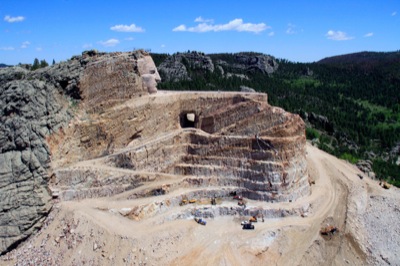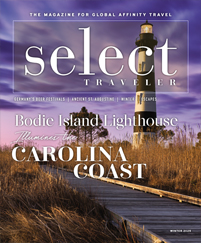
Courtesy Crazy Horse Memorial
Two of the country’s most iconic monuments are a short drive from Rapid City, one a symbol of the United States for 70 years, the other an ongoing work for more than 60 years.
When completed, the sculpture of Lakota Indian chief Crazy Horse astride his horse at the Crazy Horse Memorial will be the largest sculpture in the world, measuring 563 feet high and 641 feet long. The 90-foot face of Crazy Horse is complete, and work is progressing on the 219-foot-high horse’s head.
The mammoth project was begun by the late Polish-born sculptor Korczak Ziolkowski in 1948 and has been continued by his widow, Ruth, and their children.
“There is no definite answer as to when it will be complete,” Ruth Ziolkowski says in an introductory video at the site.
In addition to the ongoing sculpture, the Crazy Horse Memorial site has a large stone-and-timber building that houses an orientation center with a wall of windows overlooking the mountain and the Indian Museum of North America with its impressive collection of art and artifacts.
The Crazy Horse Memorial joins another American icon carved into the granite of the Black Hills: Mount Rushmore.
The 60-foot-high faces of George Washington, Thomas Jefferson, Abraham Lincoln and Theodore Roosevelt, carved by Gutzon Borglum and his son, Lincoln, from 1927 to 1941, are an inspiring American shrine.
A 30-minute detour north off I-90 takes groups to South Dakota’s capital, Pierre, where the Cultural Heritage Center is built into the side of a Missouri River bluff; native prairie grasses cover its roof and sides.
The museum provides a comprehensive look at the state’s history that includes a large section on the Plains Indians. Other exhibits tell the stories of explorers, gold miners and pioneers, with displays such as an authentic Deadwood stagecoach, a sod house and a simulated gold mine.
The state Capitol, built in 1910, has beautiful mosaic floors, marble staircases, stained-glass skylights and period artwork. Be on the lookout in the terrazzo flooring for small blue stones, reportedly signature stones for the 66 Italian artists who laid the floor. Only 55 of the 66 blue stones have been found.
Art of a different kind is featured in Sioux Falls, where more than 50 outdoor sculptures are displayed year-round in the downtown as part of SculptureWalk. All the sculptures are for sale and are changed out after one year.
“Some are very eclectic, and some are very structured,” said Cathy Buccheim, sales manager for the Sioux Falls Convention and Visitors Bureau. “It is a real wide variety.”
People vote on their favorite, and the city purchases the winner each year and places it in Falls Park, which surrounds the city’s namesake, the waterfalls of the Big Sioux River.
“The park is right in the heart of downtown,” said Buccheim. “Each second, an average of 7,400 gallons of water drops 100 feet over the triple waterfalls. You can be right on top of the water.”
You can also be well above the water in the five-story observation tower adjacent to the park’s visitors center.
“You can see quite a different view from on top,” said Buccheim. “You can go outside and see a 360-degree view of the park and downtown.”
Each night from Memorial Day to Labor Day, a laser light show on the falls tells the story of the city.
The 123-acre park also has the ruins of a 19th-century mill, and a cafe overlooking the falls is housed in a former hydroelectric power plant.
Wildlife is the star at two of Sioux Falls’ most popular attractions. Hundreds of butterflies from Central America and South America, Africa, Asia and Australia flutter about the 3,600 square-foot indoor tropical garden at the Sertoma Butterfly House.
The unusual Great Plains Zoo and Delbridge Museum of Natural History combines live animals from around the world with a museum of 150 mounted animals, including 36 “vanishing species.”
“Some are in natural settings, some in painted exhibits,” said Buccheim. “As they get the funds, they add to the exhibits.”
The zoo has about 1,000 live animals representing a wide variety of species from the Great Plains and around the world, among them giraffes, zebras, rhinoceroses, tigers, cheetahs, ostriches, meerkats and bears.
Groups can arrange to have a special animal encounter or behind-the-scenes tour.
While in the Sioux Falls area, groups should also check out the Old Courthouse Museum located in the 19th-century quartzite former courthouse, peruse the American Indian-made items at the Prairie Star Gallery, marvel at the Romanesque and French Renaissance St. Joseph Cathedral and sample some of the 23 varieties of South Dakota wine made at the Strawbale Winery in Renner, which is made of straw bales.
South Dakota Department of Tourism
800-952-3625
www.travelsd.com









